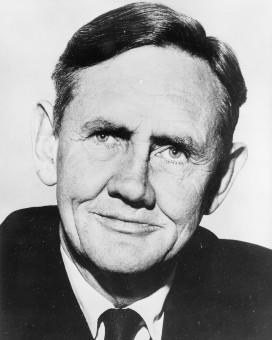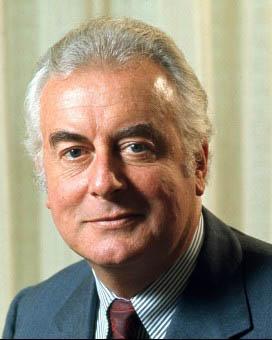William McMahon held the House of Representatives seat of Lowe for 33 years, from 1949 until his retirement from parliament in 1982. In that time, he contested the seat in 14 federal elections. He was the first to hold the seat, created in the 1949 electoral distribution. The seat now extends across inner western Sydney suburbs from Homebush Bay in the west, to Drummoyne in the east and Enfield in the south. It is bordered on the north by the Parramatta River.

William McMahon was one of the new members who won parliamentary seats in the Liberal Party victory at the 1949 federal election. Known as the '49-ers', the group included Paul Hasluck and John Gorton. NAA: A11466, 3/6, p.6
10 December 1949
The Liberal Party led by Robert Menzies won government with 55 seats in the House of Representatives, to the Country Party’s 19 and Labor’s 47. In 1949, the size of the House of Representatives was increased from 74 to 121 seats.
This election brought in the new Liberal members later known as the ‘49ers’, including Paul Hasluck, John Gorton and William McMahon, who won the new Sydney suburban seat of Lowe.
At this election, the Senate was enlarged from 36 to 60 seats, so that there were 42 seats to be contested. The coalition won 23 seats and Labor 19.
28 April 1951
After the Labor-dominated Senate refused to pass the government’s banking legislation, Robert Menzies obtained a double dissolution of parliament, the first since 1914. Menzies’ coalition government was returned with a reduced majority in the House of Representatives, but with control of the Senate. In the House, the Liberal Party won 52 and the Labor Party won 54 seats, and the Country Party 17 seats. McMahon held the seat of Lowe he had won 17 months before. Of the 60 Senate seats, the coalition won 32, and Labor 28.
29 May 1954
In the aftermath of the defection of Soviet embassy officials Vladimir and Evdokia Petrov the month before, this House of Representatives election returned the coalition government of Robert Menzies and Arthur Fadden. The Liberal Party won 47 seats, the Country Party 17 seats and Labor 57 seats in the House. McMahon was returned in Lowe.
10 December 1955
After the formation of an anti-Communist grouping split the Labor Party early in 1955, Prime Minister Robert Menzies obtained an early dissolution of parliament on the grounds of bringing together the elections for both Houses. The Menzies–Fadden coalition was returned with an increased majority, with 57 Liberal, 18 Country Party and 47 Labor seats in the House of Representatives. McMahon retained his seat of Lowe. In the half-Senate election, of the 30 seats contested, the coalition won 16, Labor 12, Anti-Communist Labor 1 and Country-Western Australia 1.
22 November 1958
John McEwen replaced Arthur Fadden as leader of the Country Party and deputy Prime Minister in March 1958. At this election, the Menzies–McEwen coalition was returned with a substantial majority. In the House of Representatives the Liberal Party won 58 seats, the Country Party 19 and Labor 45. McMahon remained the Member for Lowe. Of the 32 Senate seats contested, however, the coalition and Labor each won 15. The other 2 seats were won by the Democratic Labor Party and Country-Western Australia. The 1958 election campaign was the first where television was widely used by the parties.
9 December 1961
At this election, the Menzies–McEwen coalition narrowly retained government, with 45 Liberal and 17 Country Party seats to Labor’s 60. The coalition thus governed by a majority of one seat after a Speaker was elected in the House of Representatives. McMahon was returned again for Lowe. Of the 31 Senate seats contested at this election, the coalition won 15 and Labor 14, with 1 Country-Western Australia and 1 ‘other’.
30 November 1963
Robert Menzies called this House of Representatives election early, and obtained an improved majority with 52 House of Representatives seats won by the Liberal Party, including McMahon’s seat of Lowe, 20 by the Country Party and 50 by Labor.
26 November 1966
The Liberal Party won 61 seats, the Country Party 21 and the Labor Party 41 seats in this House of Representatives election, and there was 1 Independent. McMahon held Lowe in his 8th election for the seat.
25 October 1969
The Gorton government was returned at this House of Representatives election, including Lowe, though with increased dependence on its coalition partner. The Liberal Party won 46 seats and the Country Party 20, with Labor increasing its seats to 59. The Democratic Labor Party and Australia Party also contested this election, without success. William McMahon replaced John Gorton as Prime Minister on 10 March 1971.
2 December 1972
The William McMahon–Doug Anthony coalition was not returned, with Labor winning 67 seats in the House of Representatives to the Liberal Party’s 38 and the Country Party’s 20. The Democratic Labor Party and Australia Party candidates were again unsuccessful.
18 May 1974
Prime Minister Gough Whitlam secured a double dissolution election, but the new Senate was evenly balanced with the government holding 29 seats, the Liberal Party 23 and the Country Party 6. The balance of power was held by an Independent senator and one representing the Liberal Movement. In the House of Representatives the Labor Party remained in government with 66 seats, to the Liberal Party’s 40, and the Country Party’s 21. McMahon remained the Member for Lowe.
13 December 1975
This double dissolution election was held after Governor-General Sir John Kerr dismissed the government of Gough Whitlam and appointed Malcolm Fraser as caretaker Prime Minister. The Fraser government was elected with a resounding majority. The Liberal Party won 68 seats to Labor’s 36, with the National Country Party (name changed from the Country Party on 2 May 1975) winning 23 seats. McMahon held Lowe, and was once again in government.
At the 1975 double dissolution election, 64 Senate seats were contested. The increase in the size of the Senate was the result of allocating 2 Senate seats each to the Northern Territory and the Australian Capital Territory. In the Senate, 27 Liberal and 27 Labor senators were elected, with 7 National Country Party, 1 Independent senator and 1 from each of Liberal Movement and the Country Liberal Party.
10 December 1977
The Fraser government maintained its strong majority in the House of Representatives, winning 67 seats to the Labor Party’s 38, with 19 seats going to the National Country Party. In the Senate, the government improved its position slightly, winning 16 seats to Labor’s 14, with the National Country Party and the Country Liberal Party winning 1 seat each. The Australian Democrats entered parliament for the first time, winning 2 Senate seats.
18 October 1980
The Fraser government remained in office, though the Liberal Party decreased its House of Representatives seats to 54, with the National Country Party winning 20 seats, while Labor increased to 51. This was the last election contested by William McMahon, who had held the seat of Lowe since 1949. In the Senate, the Liberal Party won 12 seats, the Labor Party 15, with 2 National Country Party, 1 Country Liberal Party and 1 Independent. The Australian Democrats increased their seats to 5.
Sources
These brief election results relate only to this Prime Minister. They are drawn from the online sources below, where further information can be found.
Australian Electoral Commission: Election results
University of Western Australia: Australian Government and Politics Database





